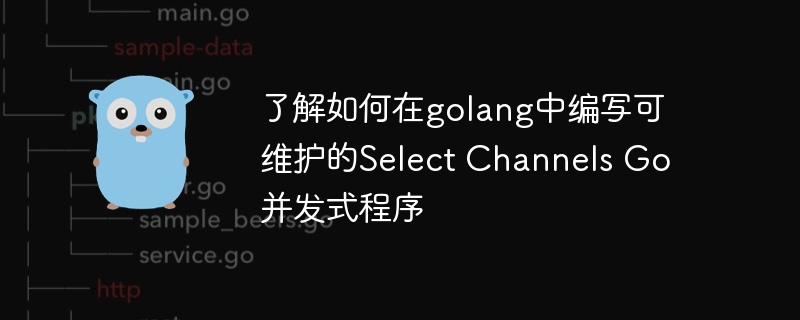Home >Backend Development >Golang >Learn how to write maintainable Select Channels Go concurrent programs in golang
Learn how to write maintainable Select Channels Go concurrent programs in golang
- WBOYWBOYWBOYWBOYWBOYWBOYWBOYWBOYWBOYWBOYWBOYWBOYWBOriginal
- 2023-09-29 13:40:591580browse

Learn how to write maintainable Select Channels Go concurrent programs in golang
Introduction:
The Go language is known for its concise syntax and powerful concurrency capabilities And loved by developers. In Go, we can use channels and select statements to write efficient concurrent programs. This article aims to introduce how to write maintainable select channels concurrent programs in Go and give specific code examples.
1. Understanding Channels and Select statements
In the Go language, channel is a mechanism for communication between coroutines. By using channels, we can send and receive data between different coroutines. The select statement allows us to make non-blocking selections between multiple channels.
The following is a simple sample code that demonstrates how to use channels and select statements:
package main
import "fmt"
func main() {
c1 := make(chan string)
c2 := make(chan string)
go func() {
c1 <- "Hello"
}()
go func() {
c2 <- "World"
}()
select {
case msg1 := <-c1:
fmt.Println(msg1)
case msg2 := <-c2:
fmt.Println(msg2)
}
}In the above code, we created two string type channels, respectively for sending Messages "Hello" and "World". Through two anonymous coroutines, we sent messages to these two channels. In the main function, through the select statement, we can select a non-blocking receive operation from multiple channels. In this example, we select the message received first and print it.
2. Tips for writing maintainable Select Channels programs
- Use named channels:
In actual projects, it is likely that there will be multiple channels in one program communicate. In order to improve the readability and maintainability of the code, we should give each channel a meaningful name.
For example, for a chat room project, we can have a channel named messageChannel for receiving and sending chat messages. Such naming makes it easy to understand the intent of the code.
- Use enumeration types to identify different channels:
In actual projects, we may need to distinguish multiple different types of channels. In order to clearly express the meaning of each channel, we can use enumeration types to identify different channels.
type ChannelType int
const (
MessageChannel ChannelType = iota
EventChannel
ErrorChannel
)In this example, we define an enumeration type of ChannelType to represent different channels. MessageChannel, EventChannel and ErrorChannel are the possible values of this enumeration type.
- Use structures to encapsulate channels
In some complex concurrent programs, we may need to manage a large number of channels. In order to avoid confusion and duplication of code, we can use structures to encapsulate related channels and provide a unified interface for operations.
The following is a sample code:
type ChannelManager struct {
messageChannel chan string
eventChannel chan string
errorChannel chan error
}
func (cm *ChannelManager) SendMessage(msg string) {
cm.messageChannel <- msg
}
func (cm *ChannelManager) SendEvent(event string) {
cm.eventChannel <- event
}
func (cm *ChannelManager) SendError(err error) {
cm.errorChannel <- err
}By encapsulating channels into a structure, we can better organize the code and improve the maintainability and reusability of the code.
3. Conclusion
Go language provides powerful concurrent programming capabilities. By using channel and select statements, we can easily write efficient concurrent programs. When writing maintainable select channels concurrent programs, we can follow some techniques, such as using named channels, using enumeration types to identify different channels, and using structures to encapsulate related channels.
By following these tips, we can better organize our code and improve its readability and maintainability. I hope this article helps you understand how to write maintainable select channels concurrent programs!
The above is the detailed content of Learn how to write maintainable Select Channels Go concurrent programs in golang. For more information, please follow other related articles on the PHP Chinese website!

